The Acer Swift 3 SF314 Notebook Review: Swift Gets Swifter With Ryzen 4000
by Brett Howse & Andrei Frumusanu on May 5, 2020 8:00 AM EST
Almost two years ago to the day, we had a chance to check out Acer’s Swift 3 laptop featuring AMD's first Ryzen Mobile platform, Raven Ridge. Acer has been a strong partner for AMD, generally being one of the first out of the gate with new designs featuring AMD’s latest platforms, and this year that partnership has played out again. Today we are taking a look at the newest AMD APU offering, the Ryzen 4000 "Renoir", which is at the heart of Acer’s latest iteration of the 14-inch Swift 3. With a brand-new AMD processor and some innovations in the Swift 3 design itself, both AMD and Acer have made some tremendous improvements for 2020.
Ryzen 7 4700U
The big news for 2020 is AMD’s new APU platform, codenamed Renoir. Selling as the Ryzen 4000 series, these new APUs bring a number of major updates to AMD's platform, as the company further sands down the rough edges from the Ryzen 3000 Picasso series. Key to this is a much-needed jump from GlobalFoundries' 12nm process to TSMC's class-leading 7nm process, giving AMD a much-wanted boost in transistor performance and overall energy efficiency. Coupled with a number of further optimizations at the chip and driver level, and AMD's latest APUs are proving far better suited for thin-and-light mobile designs than their predecessors.
Under the hood, like AMD's desktop processors introduced last year, the new Ryzen 4000 series APUs are the first laptop-focused products from AMD which feature their Zen 2 CPU cores. Designed hand-in-hand with TSMC's 7nm process, the Zen 2 architecture has further boosted AMD's performance across both IPC and clockspeeds, and the small cores have allowed AMD to get away with 8 of them in even a laptop APU. Meanwhile the iGPU is based on the same Vega architecture graphics as both the 2000-series and 3000-series APUs, but in a new configuration. Thanks to TSMC’s 7nm process, AMD has been able to crank up the GPU frequency much higher than before – so much higher that they’ve actually scaled back on the number of GPU compute units, while still promising improved GPU performance over the previous generation of APUs.
Ian had a chance to take the new Ryzen 4000 platform for a spin in early April, although that sample was the 45-Watt H series. Many of the concepts carry across though, so if you’ve not yet had a chance to catch up on Renoir, be sure to check out the Ryzen 9 4900HS review. The 45-Watt processor range is pretty much the standard in high-performance notebooks, but the vast majority of laptops on the market stick to the lower-powered 15-Watt range, which is what we have in the Acer Swift 3.
Acer has opted for what is likely to be one of the most popular SKUs in the AMD Ryzen 4000 range, the Ryzen 7 4700U. AMD has gone a very non-traditional route for this part, offering eight physical CPU cores, but disabling simultaneous multithreading (SMT). All of AMD’s H-Series lineup of 45-Watt processors do offer SMT, but only two of the new U-Series provide this, with the Ryzen 5 4600U offering 6 cores and 12 threads, and the Ryzen 7 4800U providing 8 cores and 16 threads, all in the 15-Watt thermal design power (TDP) that is so common on laptops. In the typical 15-Watt laptop space, AMD is the first to offer 8 cores, just not always with SMT.
On the GPU side, the Ryzen 7 4700U offers 7 Vega-architecture Compute Units (CUs), with a maximum clockspeed of 1600 MHz. Compared to the previous generation Ryzen 7 3700U, the GPU drops three compute units, but bumps the maximum frequency from 1300 MHz to 1600 MHz, so we shall see where this plays out in terms of performance.
The Acer Swift 3
Acer has managed to bundle a lot of product into the Swift 3. The 14-inch notebook features a 1920x1080 IPS display that, albeit lacking touch support, does get showcased well thanks to the Swift 3's thin bezel surround. The laptop ships with 8 GB of DDR4-3200, and though we would have loved to see LPDDR4X, the capacity is what is important here, and 8 GB is a good amount for a budget-friendly laptop like the Swift 3. Also, Acer has managed to outfit this notebook with a 512 GB SSD, which is fantastic. They will also be offering a less-expensive version with a Ryzen 5 4500U, 8 GB of RAM, and a 256 GB SSD.
| Acer Swift 3 SF314-42 | |||||
| Ryzen 5 | Ryzen 7 Model Reviewed |
||||
| CPU | AMD Ryzen 5 4500U 6 core 6 thread 2.3-4.0 GHz 2x 4MB L3 15W TDP |
AMD Ryzen 7 4700U 8 core 8 thread 2.0-4.1 GHz 2x 4MB L3 15W TDP |
|||
| GPU | AMD Vega 6 6 CUs 1500MHz Boost |
AMD Vega 7 7 CUs 1600MHz Boost |
|||
| RAM | 8 GB Dual-Channel DDR4-3200 | ||||
| Storage | 256 GB PCIe NVMe SSD | 512 GB PCIe NVMe SSD | |||
| Display | 14-inch 1920x1080 IPS | ||||
| Networking | Intel Wi-Fi 6 AX200 2x2:2 802.11ax Bluetooth 5.0 |
||||
| Audio | Stereo Speakers DTS Sound |
||||
| Battery | 48 Wh Li-Ion 65-Watt Charger (barrel connector) USB Power Delivery Support |
||||
| Right Side | USB 2.0 x 1 Headset jack Battery Charge Indicator |
||||
| Left Side | USB 3.2 Gen 1 x 1 with power-off charging USB 3.2 Gen 2 Type-C w/DisplayPort, PD HDMI 2.0 Charging connector |
||||
| Dimensions | 323.4 x 218.9 x 15.95 mm 12.73 x 8.62 x 0.63 inches |
||||
| Weight | 1.2 kg / 2.65 lbs | ||||
| Camera | 720p Super High Dynamic Range | ||||
| Extras | Fingerprint Reader | ||||
| Price (MSRP) | $629 USD | $649 USD | |||
Despite the strong APU, RAM, and storage offerings, Acer is not done there. The Swift 3 also features Wi-Fi 6 thanks to Intel’s AX200 wireless adapter, which means 2.4/5.0 GHz wireless support with 160 Mhz channels if your router is has the correct capabilities. There’s also an integrated fingerprint reader for Windows Hello Support, and the entire package is contained in an all-aluminum chassis which weighs just 1.2 kg / 2.65 lbs. Considering the $649 MSRP, this is an incredible value.











191 Comments
View All Comments
Roland00Address - Monday, May 11, 2020 - link
MSRP prices are never rational, especially on commodities who often sell much less than their MSRP. While "branded / halo" items rarely deviate from their MSRPs.yeeeeman - Tuesday, May 5, 2020 - link
"and allows them to compete not just on performance, but battery life as well" - how it allows them to compete when we clearly see in the normalized test that they are 25% worse compared to Intel?yeeeeman - Tuesday, May 5, 2020 - link
Nevertheless, the implementation is disappointing since it cannot sustain a stable frequency, so gaming will be hard on this...I guess that 650$ price is not without of reason...Steve1992 - Tuesday, May 5, 2020 - link
The frequencies are fine: https://youtu.be/Xyns9jjEt5MSteve1992 - Tuesday, May 5, 2020 - link
Better example: https://youtu.be/pGgY-Aw2dZoneblogai - Tuesday, May 5, 2020 - link
They are OK, but could be better. iGPU can keep the frequences in CPU-light games, but drops them in CPU heavy games like Forza Horizon, Dota2, and especially Battlefield V multiplayer. Also, in case of GTA5 benchmark you posted- note that the video starts with APU at 25W, which is while APU is still boosting (several minutes). Then it goes to sustained power limit of 18W, and will stay there, with lower power and clocks.Flunk - Tuesday, May 5, 2020 - link
Low priced thin and lights with integrated graphics are all pretty much useless for gaming. It's not a reasonable or use case... at least according to notebook designers.DanNeely - Tuesday, May 5, 2020 - link
Gaming on a laptop with an IGP will never be a great experience because you either have to turn the quality settings down a lot or play older/less graphically complex titles; but that doesn't mean people don't do it. There's no easy way to get a desktop/mobile split, but ~10% of systems in the Steam HW Survey use some Intel GPU; I suspect a majority of them are laptops because it's where you're stuck with the IGP and can't slap in even a cheap discrete GPU for faster speeds.The GPU here isn't a 200W discrete card, or even a 40W discrete card; but it is a step above Intel's IGPs. That makes it an attractive option for someone who wants to be able to game on a laptop without spending a lot more and sacrificing profitability.
I do it some of the time when away from home on an old XPS13 with a i7-6xxx. It's a limited experience, especially after this many years, but is still better than mobile gaming on my phone.
philehidiot - Tuesday, May 5, 2020 - link
It has always been the case that if you want a decent gaming laptop, you're paying big bucks. I think the pricing here is pretty damned awesome. I'd never buy a laptop like this for gaming. It's that simple. The Vega GPU is kinda nice to have but integrated graphics are simply not meant for decent gaming. It's that simple. If you're looking at this and thinking "ooh gaming machine", you need to recalibrate your expectations.neblogai - Tuesday, May 5, 2020 - link
Well, gaming does not have to be the latest AAA specifically. Majority of best games will run on this integrated Vega very well. Most E-sports are also playble. And even a lot of best latest AAA will run well enough to experience and enjoy the game (if the game has to offer more than just graphics).